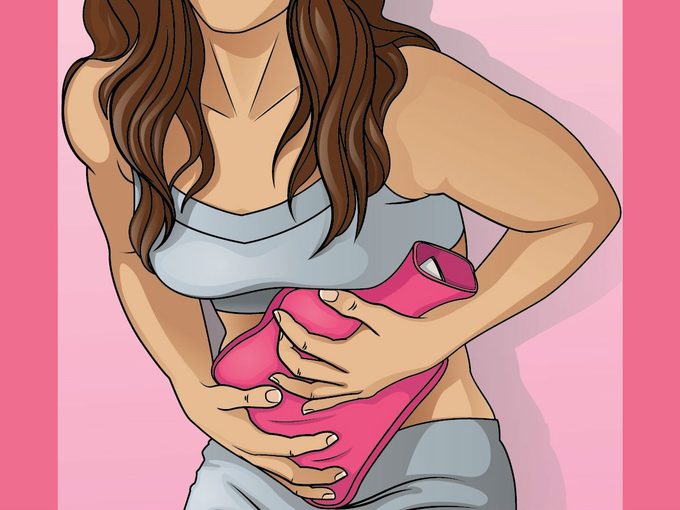What is Up With Your Period? Find Out If You Have One of These Menstrual Disorders
Lots of things can disrupt your cycle, including disease, diet or weight changes, emotion and more. Do you have one of these period issues?

Is your period wonky? Find out what exactly is going on down there.
Menstruation depends on the complex interaction of hormones that govern the menstrual cycle. Anything that disrupts this, such as disease, diet or weight changes, emotion or faulty development of the reproductive organs, can cause menstrual problems.
Symptoms and Treatment of Menstrual Disorders
Premenstrual syndrome (PMS)
Most women experience some physical and mental changes in the week or so before menstruation. However, some women find that these symptoms are severe enough to disrupt their everyday lives. Symptoms include mood swings, irritability, depression, anxiety, insomnia and physical symptoms such as bloating, tender, swollen breasts and weight gain. They usually all disappear as soon as menstruation begins. A low-salt, wholefood diet, exercise and supplements such as B6 and evening primrose oil can often help to control PMS. A variety of drugs, ranging from diuretics to hormonal drugs, are sometimes used to treat more severe cases.
Some women experience a severe form of PMS called premenstrual dysphoric disorder (PMDD), in which mood symptoms are a particular problem. SSRI antidepressants may be helpful in this case.
Dysmenorrhoea (painful menstruation)
An estimated 50 per cent of women experience pain before or during their period and some 10 per cent suffer severe pain. The pain is typically experienced as fluctuating cramps, similar to early labour pains, in the lower abdomen. These may spread to the thighs and lower back. In severe cases, there may be nausea, vomiting, diarrhoea, dizziness and headaches. There are two kinds of dysmenorrhoea – primary dysmenorrhoea and secondary dysmenorrhoea.
- Primary dysmenorrhoea affects women of any age, but is often relieved after childbirth. There is no identifiable underlying cause, although some experts believe it may be linked to high levels of hormone-like substances called prostaglandins, which cause the uterus to contract. The pain generally begins with menstruation and tends to be worse on the first day or so of the cycle. Drugs that quell prostaglandins, including aspirin, can help. Other medications may include the oral contraceptive pill.
- Secondary dysmenorrhoea tends to affect older women and may be caused by a number of underlying physical disorders such as fibroids, polyps, endometriosis, adenomyosis and pelvic inflammatory disease (PID). Occasionally, the problem is due to narrowing of the opening from the cervix into the vagina. Treatment depends on the underlying cause, but may include hormonal drugs and surgery such as hysterectomy.
Find out if you can stop your period and if it is healthy for your body to do that.
Cycle disturbances
Few women menstruate exactly every 28 days, and anything from 21–42 days can be normal for a particular woman. Cycles often become erratic as a woman nears menopause, but this can also be a sign of overgrowth of the endometrium (endometrial hyperplasia) caused by lack of ovulation. In mild cases, progestogen may be prescribed, but in more severe cases, surgery may be needed. Low levels of reproductive hormones may cause extremely short cycles with frequent bleeding (polymenorrhoea), which may also result from other hormonal disorders such as thyroid problems. Long regular cycles may be normal for some women. However, in other cases, particularly where the cycles are irregular, there may be a problem such as ovarian cysts or an underlying hormonal disorder.
Menorrhagia (heavy periods)
Heavy periods are defined as the loss of 80ml or more of menstrual blood each period (the average is 30–40ml or 6 to 8 teaspoons). In practice, this means having to change pads or tampons extremely frequently, together with the passage of large clots. There may also be cramp-like pains. Persistent menorrhagia can lead to anaemia.
In many cases menorrhagia has no identifiable cause. In others, the cause may be fibroids or fibromyomas, or an IUD (intrauterine device). Heavy periods tend to be more common following sterilization. Obesity and hormonal abnormalities may also be a cause. Treatment depends on the underlying cause, but may include the oral contraceptive pill or a specialized IUD that releases progestogen (called Mirena). A number of hormonal medications and, in severe cases, removal of the endometrium or uterus (hysterectomy) may also be recommended.
Are you spotting? Find out why mid-cycle bleeding might be happening to you.
Amenorrhoea (lack of periods)
There are two types of amenorrhoea – primary amenorrhoea, defined as failure to begin menstruating by the age of 16, and secondary amenorrhoea, a temporary or permanent failure of menstruation in a woman who has previously had regular periods.
- Primary amenorrhoea affects about 3 girls in 1000. It is normally simply a case of beginning puberty late and may be hereditary. In some cases, it may be a result of a disease such as tuberculosis, meningitis or encephalitis. Alternatively, it may be a result of abnormalities in the reproductive system, or may indicate a disorder of the endocrine system. Other possible causes include excessive exercise, anorexia nervosa and excessive weight loss, which causes insufficient ovary-producing hormones to be produced, leading to low levels of estrogen.
- Secondary amenorrhoea can have a number of different causes. In a sexually active woman who has previously menstruated regularly, pregnancy is the most common cause.
- Ovarian cysts can also cause this issue, as well as tumours, ovarian cysts, significant weight gain or loss or a number of hormonal disturbances, which affect ovulation. Polycystic ovary syndrome, for example, is a hormonal disorder in which multiple cysts form in the ovaries, leading to menstrual disturbances or absence of menstruation.
Have you tried period panties?
Lifestyle Changes
Research into premenstrual problems has shown that both magnesium supplements and electrical nerve stimulation may reduce prostaglandin-induced menstrual pain. For heavy periods, an IUD that releases small doses of a progesterone-like substance – also known as an IUS – can help to treat heavy bleeding.
What’s Up Down There? 13 Things Your Vagina Secretly Wants to Tell You




